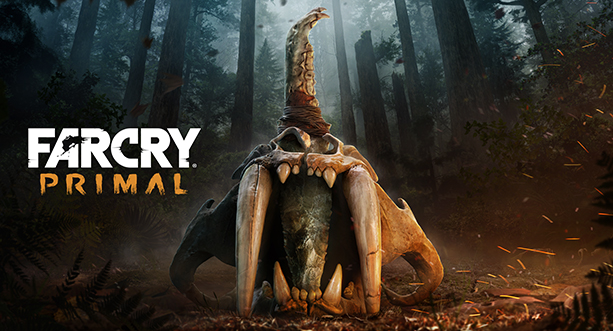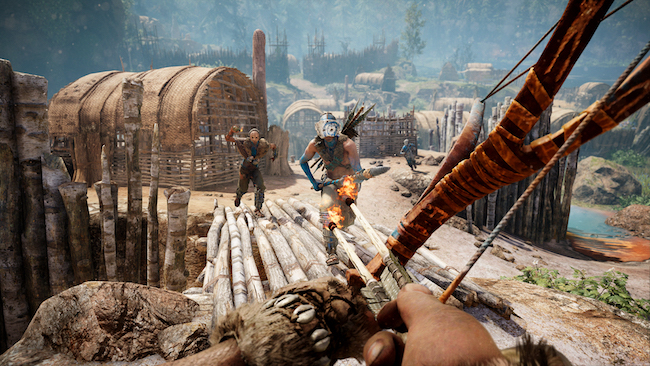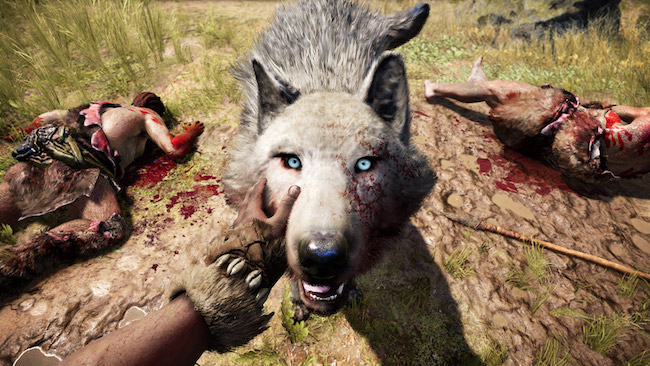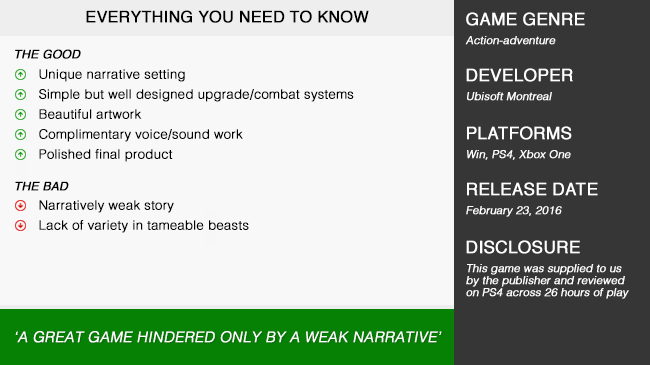
When I heard the announcement for Far Cry Primal some time ago now, I was intrigued but not overwhelmingly enthused to pick it up right away. As a professional hoarder and procrastinator when it comes to games, I already own Far Cry 1 through 3 and haven’t found the time to play any of them among the pile of titles that keeps amassing both on my shelves and in my Steam library. However, being given the opportunity to review the game has finally broken my streak – and allowed me to see what all the fuss is about some time after the hype that surrounded Far Cry 3.
In Far Cry Primal, you play as Takkar – a tribesman who becomes isolated from his clan during a hunting expedition. As he begins his journey, Takkar sets out slowly to establish a village filled with his clansmen, the Wenja. As he gradually discovers more about his tribe and their enemies, he comes across many notable figures who aid him in his quest to unite his tribe and protect them from the people and creatures of the land. This sums up the crux of the story, and Far Cry Primal doesn’t get too much more narratively complex from there.

Understandably, the selling point of these games isn’t the narrative – so to let the stronger creative elements shine through, it’s a given that the storyline is broad and unrefined to let the rest of the game speak for itself. Of course, while I’ll get to the gameplay soon enough, I’d like to say I’m a little disappointed that there’s not more meat on the narrative skeleton of Far Cry Primal. The game touches on a mostly unexplored time period (for games), and skims the surface of some fascinating topics such as nature, early tribal warfare and spirituality, but doesn’t really delve far enough into any of them to warrant a commendation.
One of the primary areas where Far Cry Primal succeeds, in my eyes, is the game design. Having both the skill and crafting trees gradually become unlockable through questing and upgrades works really well, and it also kind of felt as if this process fit the setting – in a time where obviously inventions were primitive. How much more aesthetically pleasing can a club made out of wood, skin and stone get? While not new to the franchise, it resonated will with me as a first-time player as it allows the difficulty of the game to gradually roll out in front of you.

This also put a huge emphasis on resource collection, which, at the higher levels of crafting, meant exploration also played a significant role if you were to find the rarer components needed to finish the entire process. Overall, despite being simple in structure, I thought this particular design mechanic was excellent and instilled enough of a sense of customization and choice to make you feel as if you were shaping your own version of Takkar, depending on your playstyle.
Do you like riding wooly mammoths, sabertooth tigers or bears? Of course you do! This was just one of the cool gameplay mechanics that Primal had to offer, which was just a nice twist of flavour in a time where games are more about planes, cars, and motorbikes. This also played well into the overarching element of beast mastery, with Takkar taming creatures from across Oros to add to his menagerie and assist in traversing the wide-spanning continent. By having these creatures, it added a serving point in which to allow you to choose how you wanted to attack the game – whether at close quarters in melee with a club/spear, or picking people off at a distance with your bow, which I thought was a very different way to structure the combat choice from the ordinary.

Given that the game was set in central Europe, I suppose the creative team had to realistically stick to wildlife of the region – and in that sense perhaps the game would have been better served set in Africa? (Although, I’ve been told earlier games weren’t nearly as concerned about authentic combinations of wildlife). Personally, I would have loved to have seen some more variety in tameable creatures, as opposed to three different sorts of wolves and lions. The rest of the gameplay is very smooth, and I only ever encountered one instance where I clipped into the environment and had to reload from the main menu. For a game the sheer size of Far Cry Primal, I was impressed with how few bugs I ran into, so my hat goes off to the development team at Ubisoft for delivering a very well-polished product at release.
As I’ve mentioned in previous reviews, I’m a complete sucker for the current-generation of games graphically, and Far Cry Primal is no exception to this revelation whatsoever. With such an ample amount of well-textured nature to get lost in, Far Cry Primal is beautiful to look at and a wonder to explore from top to bottom if it tickles your fancy. This is also helped along in large part due to the composition of the soundtrack and voice work, which, being rooted in a very harsh and rough manner, aided in emphasising the primitive nature of the games setting and visual surroundings.

While Far Cry Primal isn’t the sort of game I’d typically play, I’m really glad I did because it gave me an understanding of the direction in which Ubisoft is trying to head with the series. While I think the change of setting and gameplay advancements work well, I also strongly feel Ubisoft needs to focus more on crafting a compelling narrative to accompany what is a very well developed game. In an age where both elements of story and gameplay are being explored to such a varied and exploratory depth, more than ever, gamers are calling out for their games to offer something well-rounded and unique. Sadly, Far Cry Primal isn’t unique (apart from the setting), but the elements are all there for something much greater – it’s just a matter of focusing on the weaknesses now rather than tinkering with the strengths like Ubisoft is somewhat infamous for doing (see Assassins Creed series). Despite its flaws, I found the game to be enjoyable, and I’d recommend it to first-time players like myself as a solid entry point in the Far Cry series.











